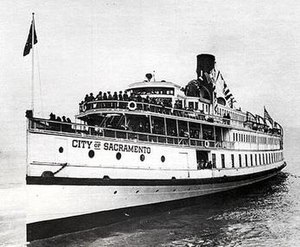City of Sacramento

Asbury Park as City of Sacramento
|
|
| History | |
|---|---|
| Name: | Asbury Park later City of Sacramento, Kahloke, Lady Grace |
| Route: | San Francisco Bay, Puget Sound. British Columbia |
| Builder: | Wm Cramp & Sons |
| In service: | 1903 |
| Identification: | US registry #107848 |
| Notes: | Transferred to west coast, 1918. |
| General characteristics | |
| Type: | coastal steamship and ferry |
| Tonnage: | as ferry : 3,016 gross; 1,829 regis. |
| Length: | 297 ft (91 m) |
| Beam: | as ferry : 50 ft (15 m) over hull; 67 ft (20 m) over guards. |
| Depth: | 15.5 ft (5 m) depth of hold |
| Deck clearance: | as ferry : 11.5 ft (4 m) on vehicle deck. |
| Ramps: | as ferry : bow loading ramp for vehicles |
| Installed power: | steam engines; converted to diesel-electric power 1952-53. |
| Propulsion: | twin propellers |
| Speed: | as built : 20 kn (37.04 km/h) |
| Crew: | as steamship : 77 |
Asbury Park was a high-speed coastal steamer built in Philadelphia, and intended to transport well-to-do persons from New York to summer homes on the New Jersey shore. This vessel was sold to West Coast interests in 1918, and later converted to an automobile ferry, serving on various routes San Francisco Bay, Puget Sound and British Columbia. This vessel was known by a number of other names, including City of Sacramento, Kahloke, Langdale Queen, and Lady Grace.
Asbury Park had a number of owners over the long career of the vessel. These included, among others, the Jersey Central Railroad (1903-1918) Monticello Steamship Co. (1918-1917); Golden Gate Ferry Co. (1918-1927), Southern Pacific Railroad, (1927-1941), Puget Sound Navigation Company, (1941-1952), Black Ball Line, Ltd, (1951-1961), and BC Ferries (1961-1976).
As built, the mechanical plant of Asbury Park consisted of twin four-cylinder, triple expansion steam engines, compound steam engine; cylinder bores 23 in (58.4 cm), 37 in (94.0 cm) and 2x 43 in (109.2 cm); stroke 30 in (76.2 cm), generating 5,900 horsepower, with each engine driving a propeller shaft. Steam was generated by nine coal-fired boilers, which ventilated through twin smoke stacks. This drove the vessel at speeds in excess of 20 kn (37.04 km/h).
The Jersey Central had a fleet of steamships which it operated from New York to points along the coast of New Jersey. Asbury Park was considered a prestige vessel and was the flagship of the Jersey Central fleet. The vessel was intended to attract wealthy patrons from New York's financial district, who would use the ship to reach their summer homes on the New Jersey shore.
With a speed of over 20 knots, she operated during the summer season between the north Jersey Shore and New York City. However, her size and speed made her ill-suited to the route, and she lacked manoeuvrability in the congested waters of New York harbour. With the decline in traffic during the First World War she was laid up during the 1917 and 1918 summer seasons.
...
Wikipedia
